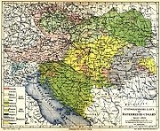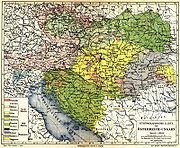
North Slavic languages
Encyclopedia

North versus South Slavic
It is sometimes used to combine the West SlavicWest Slavic languages
The West Slavic languages are a subdivision of the Slavic language group that includes Czech, Polish, Slovak, Kashubian and Sorbian.Classification:* Indo-European** Balto-Slavic*** Slavic**** West Slavic***** Czech-Slovak languages****** Czech...
and the East Slavic languages
East Slavic languages
The East Slavic languages constitute one of three regional subgroups of Slavic languages, currently spoken in Eastern Europe. It is the group with the largest numbers of speakers, far out-numbering the Western and Southern Slavic groups. Current East Slavic languages are Belarusian, Russian,...
into one group, as opposed to the South Slavic languages
South Slavic languages
The South Slavic languages comprise one of three branches of the Slavic languages. There are approximately 30 million speakers, mainly in the Balkans. These are separated geographically from speakers of the other two Slavic branches by a belt of German, Hungarian and Romanian speakers...
(much like South Germanic
South Germanic
South Germanic is a term used for a number of proposed groupings of the Germanic tribes or dialects. However, it is not widely used and has no agreed definition. The following uses are found:* As a straightforward synonym for West Germanic...
combining the West and East Germanic branches). The Southern group was separated from the rest of the Slavic dialects by the Hungarian invasion of the 9th century.
An extinct branch of Slavic
Some Slavists believe that a separate, now extinct, branch of North Slavic languages once existed, different from both West and East Slavic. The dialect formerly spoken in the vicinity of Novgorod (the so-called Old Novgorod dialectOld Novgorod dialect
Old Novgorod dialect is a term introduced by Andrey Zaliznyak to describe the astonishingly diverse linguistic features of the Old East Slavic birch bark writings from the 11th to 15th centuries excavated in Novgorod and its surroundings...
) contains several Proto-Slavic
Proto-Slavic language
Proto-Slavic is the proto-language from which Slavic languages later emerged. It was spoken before the seventh century AD. As with most other proto-languages, no attested writings have been found; the language has been reconstructed by applying the comparative method to all the attested Slavic...
archaisms that did not survive in any other Slavic language, and can in their opinion be considered a remnant of an ancient North Slavic branch.
Constructed North Slavic languages
There is also a group of artistic languageArtistic language
An artistic language is a constructed language designed for aesthetic pleasure. Unlike engineered languages or auxiliary languages, artistic languages usually have irregular grammar systems, much like natural languages. Many are designed within the context of fictional worlds, such as J. R. R....
s forming a fictional North Slavic branch of the Slavic languages
Slavic languages
The Slavic languages , a group of closely related languages of the Slavic peoples and a subgroup of Indo-European languages, have speakers in most of Eastern Europe, in much of the Balkans, in parts of Central Europe, and in the northern part of Asia.-Branches:Scholars traditionally divide Slavic...
. The authors of these languages were inspired by the existence of West, East and South Slavic languages and the absence of a (known) North Slavic group. Most of these languages therefore have an experimental character; they suppose a certain influence of the Germanic
Germanic languages
The Germanic languages constitute a sub-branch of the Indo-European language family. The common ancestor of all of the languages in this branch is called Proto-Germanic , which was spoken in approximately the mid-1st millennium BC in Iron Age northern Europe...
, Uralic
Uralic languages
The Uralic languages constitute a language family of some three dozen languages spoken by approximately 25 million people. The healthiest Uralic languages in terms of the number of native speakers are Hungarian, Finnish, Estonian, Mari and Udmurt...
, or Baltic
Baltic languages
The Baltic languages are a group of related languages belonging to the Balto-Slavic branch of the Indo-European language family and spoken mainly in areas extending east and southeast of the Baltic Sea in Northern Europe...
languages. Despite the fact that the creators of these languages have worked independently from each other and in different time frames, these languages have several elements in common. The best-known examples of constructed North Slavic languages are: Sevorian (Sievrøsku), Nassian (Nassika), Seversk, Slavëni, and Vozgian.

